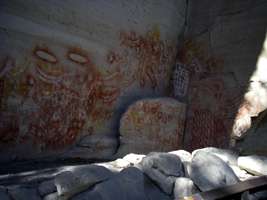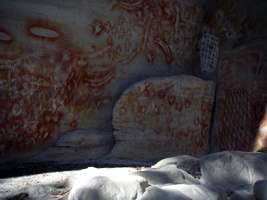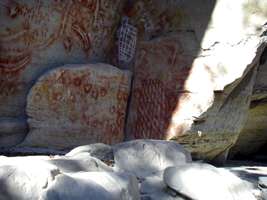Back to Don's Maps
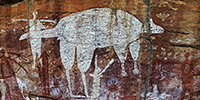 Back to Australian rock art and other Oz sites
Back to Australian rock art and other Oz sites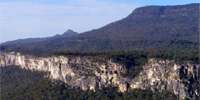 Hiking in the Carnarvon Gorge
Hiking in the Carnarvon Gorge Carnarvon Gorge
An Aboriginal Rock Stencil Art site, with engravings of vulvas, emu and kangaroo tracks
Carnarvon Gorge lies within the spectacular and rugged ranges of Queensland's central highlands. Lined with vegetation and fed by the waters of numerous side gorges, Carnarvon Creek winds between towering sandstone cliffs. The gorge is a cool and moist oasis within the dry environment of central Queensland. The fragile aboriginal art on the gorge's sandstone walls reflects a rich culture. Ochre stencils of tools, weapons, ornaments and ceremonial objects, as well as engravings and grooves where tools were sharpened provide an insight into the lives of the gorge's first people.
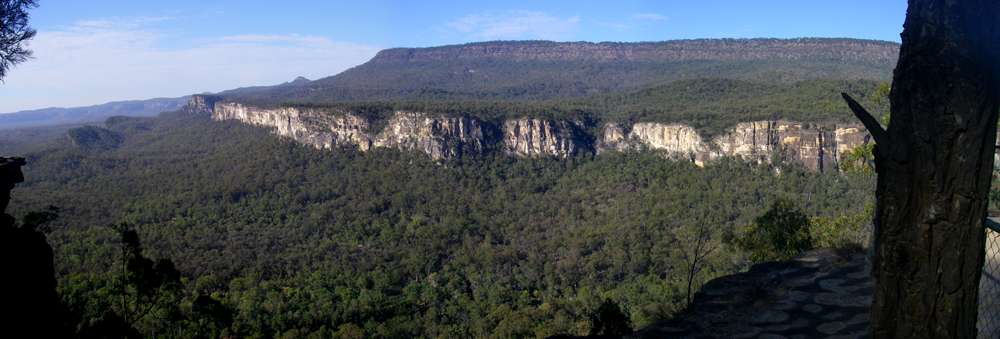
The entry to Carnarvon Gorge looking downstream from Boolimba Bluff - the gorge proper begins to the right of the photograph
Photo: Don Hitchcock, August 2009
The fragile aboriginal art on the gorge's sandstone walls reflects a rich culture. Ochre stencils of tools, weapons, ornaments and ceremonial objects, as well as engravings and grooves where tools were sharpened provide an insight into the lives of the gorge's first people.
Text above adapted from http://www.epa.qld.gov.au/parks_and_forests/.
The Art Gallery
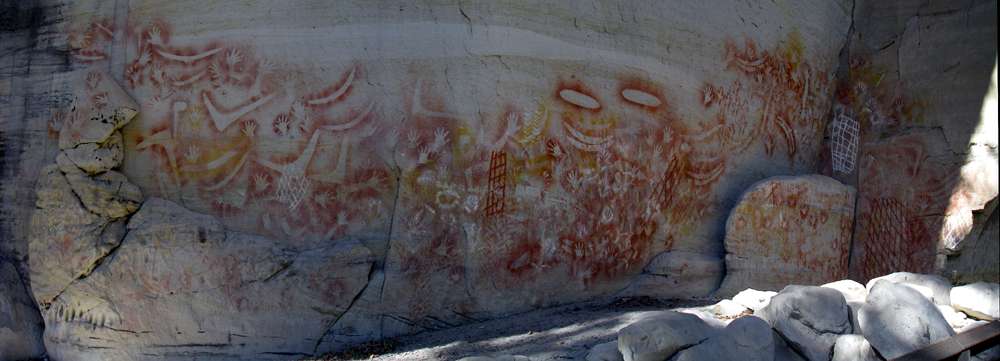

Panoramic photos of part of the 'Art Gallery' rock shelter in Carnarvon National Park.
Text: Adapted from the display at Carnarvon Gorge.
Photo: Don Hitchcock, August 2009
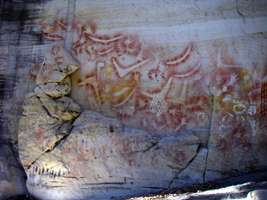
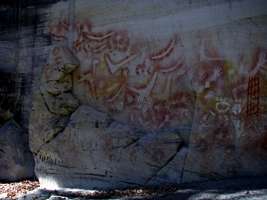
The leaf shaped boomerangs were used for hunting. The Aborigines were able to throw them with great accuracy to bring down prey such as waterfowl. These were not returning boomerangs, as the blade was flat and lacked the twist of the returning boomerangs.
The 'V' shaped boomerangs were possibly used for fights between tribes. They could be thrown sidearm, skimming just above the ground and would easily break an opponent's leg. They were also used for bringing down kangaroos in the same manner.
In contrast, the hafted stone axes also stencilled on this panel were probably used for peaceful purposes. Using these axes, sections of bark were removed from trees and used for many purposes, typically as coolamons or carrying containers.
As well as hands and arms, there appear to be two examples of stencilled feet on this section of the wall, just below and to the left of the white net, and what may be vulvas carved into the stone. The white nets represent the latter phase of Carnarvon art.
Text: Don Hitchcock, adapted from the display at Carnarvon Gorge.
Photo: Don Hitchcock, August 2009


This part of the panel includes, as well as many stencilled hands, some stencilled coolamons. There are two vertical columns of chevrons apparently painted in directly, and we can see three animals in white ochre, what might be an echidna on the left, and two goannas.
The red nets are made by blowing ochre between two fingers held just apart, though this is not obvious in the photograph. The nets are built up, tiny small triangle by tiny small triangle, in a remarkably symmetrical pattern.
Text: Don Hitchcock, adapted from the display at Carnarvon Gorge.
Photo: Don Hitchcock, August 2009
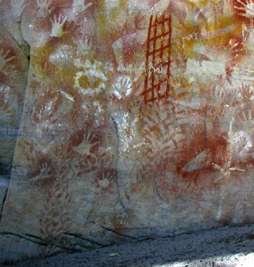
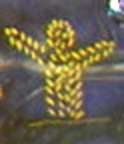
Some composite stencils were produced by blowing ochre into the gap between overlapping pairs of fingers. A number of patterns formed in this manner are present here, of which the most striking is this humanoid 'spirit' figure with outstretched arms, shown in diagrammatic form in the smaller photo on the right, rephotographed from an interpretation plaque at the site.
This is a small part of the part-panel above, and as well as the spirit figure in the left hand foreground of this photo, we can see another, larger figure of indistinct shape completed using the same technique in the centre.
There is also a goanna on the right, and what could be an echidna in the centre, both head down and both completed in freehand using white ochre.
Text: Don Hitchcock, adapted from the display at Carnarvon Gorge.
Photo: Don Hitchcock, August 2009
Here it becomes obvious that the red nets are quite symmetrical, built up painstakingly, tiny element by tiny element, but the white net has not had the same attention to symmetry lavished on it. It is likely that the white net and associated white stencilled hands (one hand is above the net and obscures part of it, and one hand is below, and is obscured by the net) were completed at a different time and by different artists.
Here we can also see, on the right, two examples of the striking 'two handed' stencil, with a forearm bearing two hands, one on each end.
Curious stencils are those of an emu's foot, apparently stencilled in that shape by using fingers or part of a hand. They do not seem to have been completed by cutting out a shape from a piece of bark, for example, because some bear signs of having been done in at least two, or possibly three operations.
Text: Don Hitchcock
Photo: Don Hitchcock, August 2009

This palm frond base from Boowinda Gorge, which enters further up Carnarvon Creek, is very similar indeed to the rectangular nets on the Aboriginal drawings in the gorge. These palm frond bases may have been a useful raw material for the Aborigines of the area.
Photo: Don Hitchcock, August 2009
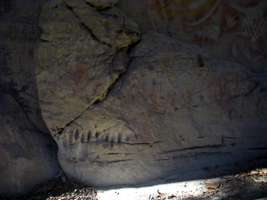
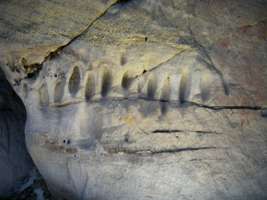
Two close ups of the rock on the extreme left of the panorama, which has what appear to be grooves from sharpening stone tools, possibly axes.
Photo: Don Hitchcock, August 2009

Another section of the 'Art Gallery' rock shelter.
I call this "The Wall of One Thousand Vulvas".
As always, click (and click again if necessary, depending on your browser) on this small image to see the full size panorama.
The image is 4900 x 1002 pixels, and is the result of stitching together five images.
One of the interpretation signs here says:
The most common engraving found here is of the human vulva. The significance of this motif is not known. Engravings of vulvas are common along the cliffs of the Great Dividing Range in this region. Nowhere else in Australia is this motif engraved in this way with such regularity.
Individual photographs used to make up this panorama are examined in more detail below:
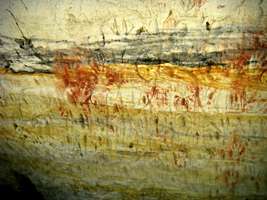
The stencilled hands in this view seem relatively recent, within the last few hundred years, as do most of the paintings on this wall.
Some of the engravings, however, appear to be many hundreds, possibly thousands of years old, judging on their condition.
As well as vulvas, in this view there are engravings of kangaroo and emu tracks.
Photo: Don Hitchcock, August 2009
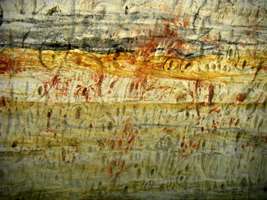
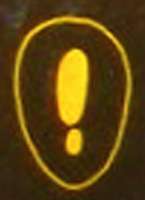
Many of the images of the vulva are as shown in the diagram on the right, rephotographed from the excellent interpretation plaques at the site, with what is apparently a vaginal opening and the anus, as suggested by both Ralph Frenken and Jean-pierre Duhard.
A group of six (possible) emu eggs is shown between two pairs of vulvas in this view. Emu eggs are a common motif in engravings in this area. As well, there are emu tracks engraved, as well as some apparently old engravings of vulvas and other enigmatic engravings rounded by time, especially towards the bottom of the wall near the present ground level.
Photo: Don Hitchcock, August 2009
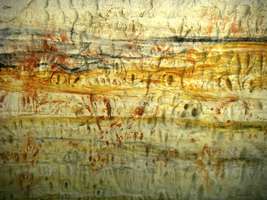
Not all the vulvas have the anatomical detail of the examples above. Some consist of an oval in bas relief, with a comparatively deep depression within.
Photo: Don Hitchcock, August 2009
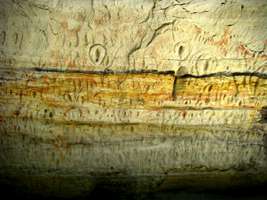

In these views we can see a group of perhaps eight predominantly teardrop-shaped depressions near the prominent vulva to the left. The two other large vulvas on the light coloured sandstone appear to be much older and more eroded than the prominent vulva.
In addition, there are a number of carved emu tracks.
Photo: Don Hitchcock, August 2009

This is a more distant shot of the wall, showing the setting in which the wall is placed.
As always, click (and click again if necessary, depending on your browser) on this small image to see the full size panorama.
The image is 3888 x 1198 pixels, and is the result of stitching together three images.
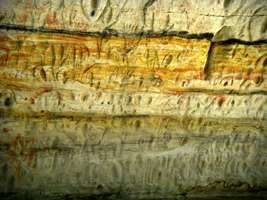
The lower, predominantly grey sandstone shown here may be more easily weathered. Certainly all the engravings on this section appear to be significantly degraded. There are some enigmatic vertical lines in this section.
Photo: Don Hitchcock, August 2009

Apart from the ubiquitous vulvas, towards the middle of this view may be seen what appears to be two engraved hands, and on the right, some fairly recent stencils of hands done in red ochre.
In the upper right section of the photograph, an attempt seems to have been made to encircle a large group of engravings with a single groove in the shape of a large oval.
Photo: Don Hitchcock, August 2009

This section has engravings of some large emu tracks, various vulvas, and a group of human hands. In addition, there are stencilled hands in both red and yellow/orange ochre.
Photo: Don Hitchcock, August 2009
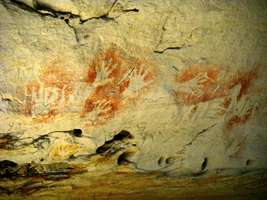
Sadly, the stupidity of vandals is evident here.
The stencilled hands are still quite sharp in outline.
Photo: Don Hitchcock, August 2009
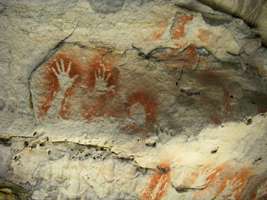
This panel has, apart from the stencilled hands, a stencil of a round object, possibly a round shell pendant, as well as what may be part of an engraving of a foot below and to the right of the round stencil.
Photo: Don Hitchcock, August 2009
Cathedral Cave
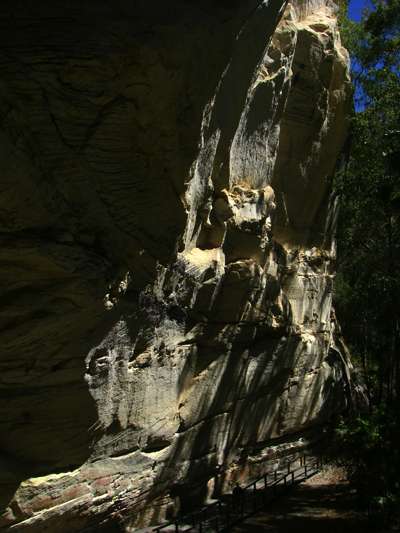
Cathedral Cave is a sandstone overhang, which has protected the paintings and engravings from the weather.
Photo: Don Hitchcock, August 2009
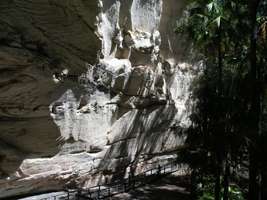
General view of Cathedral Cave.
Photo: Kathy, August 2009
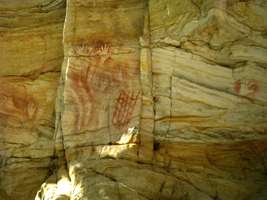
This is the most elevated art, at the left of the shelter, reached by a short staircase. It consists of several hand and boomerang stencils, as well as a net symbol.
Photo: Don Hitchcock, August 2009
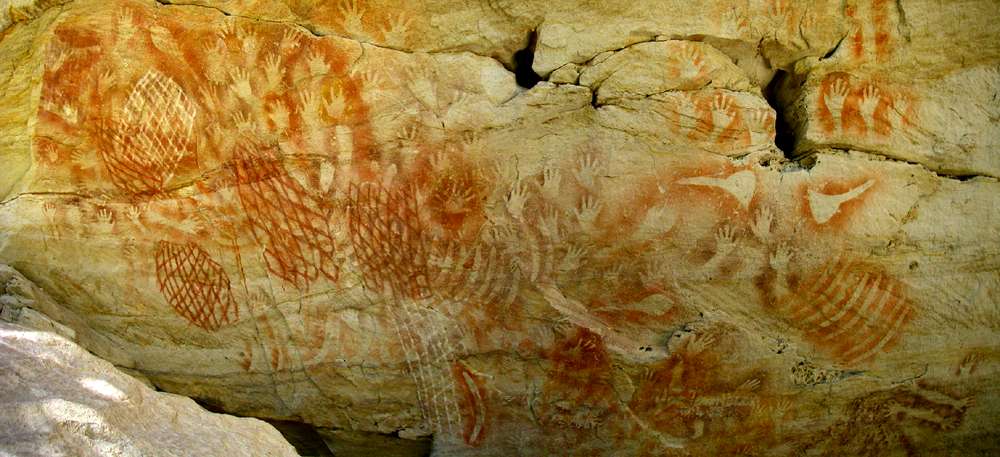
A panorama of a particularly rich section of the art in Cathedral Cave.
Photo: Don Hitchcock, August 2009
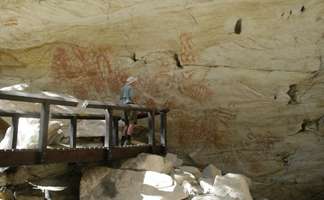
Cathedral Cave has very good viewing platforms.
Photo: Kathy, August 2009

This section is remarkable for the group of sixteen or seventeen closely packed boomerang stencils. Some researchers believe that these record the individual weapons of a group of hunters. That they were all completed at the same time is testified to by the lack of overspray from one to the other, and the same colour ochre, dark brown in this instance, is used for all of them.
The red spade shaped stencil in the upper left of the photo is believed to depict a type of flat bladed wooden war club. No examples of the weapon are known to have survived.
As well, there are white and red nets in this view, hand drawn, as well as stencils of hands and feet.
Text: Don Hitchcock, adapted from the display at Cathedral Cave.
Photo: Don Hitchcock, August 2009
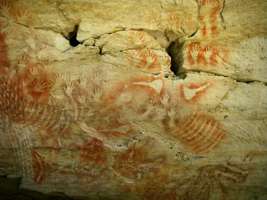
I count three, possibly five, definite repeats in red ochre of a particular right hand, and four, possibly five, in the same red ochre of a particular left hand on each side of the hole in the rock wall here. Then there are at least four repeats of the same hand in a brown/violet ochre to the left of that group. It seems that in this section, it was normal to do multiple copies of your hand.
However the most important thing about this group of stencils is the twice repeated stencil in red ochre of a large 'axe shaped' weapon, believed to depict a type of wooden 'Lil-Lil' club. No examples of this weapon have survived, and its passing is recorded only in the stencil art. The stencils appear to me to be of the same weapon, flipped and stencilled twice.
Once again we see here a group of boomerang stencils done at the same time, with no overspray, of eight different boomerangs, presumably from eight distinct hunters. In addition, there is another stencil of the red spade shaped object, depicting a type of flat bladed wooden war club.
Text: Don Hitchcock, adapted from the display at Cathedral Cave.
Photo: Don Hitchcock, August 2009

On the left of this photograph are seven stencils of boomerangs, though there has been considerable degradation in the clarity of the images over time.
The important thing about this image is the presence of three double handed forearm stencils, which have only been recorded in the Carnarvon National Park area, and appear to be an aesthetically pleasing design, possibly the work of one artist. This mauve ochre appears to denote the early sequence of stencil art in the Carnarvon area.
Another interesting feature is the presence in the same mauve ochre of hands with fingers much shorter than normal, possibly as the result of the folding over of fingers while the stencil was being completed. There are two near the single double handed forearm stencil towards the lower right of the frame, and a possible two others on the left of the photo below the seven boomerang stencils.
I am reminded of the mutilated hands stencils at Gargas in France.
Text: Don Hitchcock, adapted from the display at Cathedral Cave.
Photo: Don Hitchcock, August 2009

Close up of the pair of double handed forearm stencils.
Photo: Don Hitchcock, August 2009
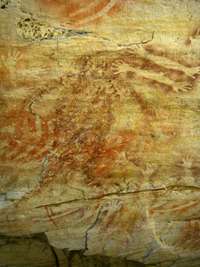
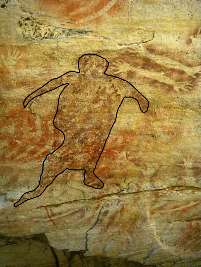
This appears to be another spirit figure, completed with a particular coloured ochre in a smudged effect, as though the figure were blocked out with something like a large brush of bark or similar material dipped in ochre.
Photo: Don Hitchcock, August 2009

Archaeological excavations were carried out in the floor deposits of this rock shelter, by Dr John Beaton in 1975. Carbon dating of campfire charcoal excavated showed that aboriginals first occupied this site approximately 3560 years ago.
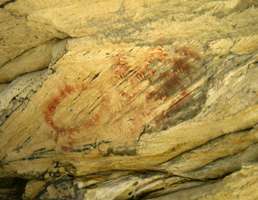
This stencil appears to be of a very broad coolamon, or possibly a war shield. It is above and to the left of the panorama above.
Photo: Don Hitchcock, August 2009
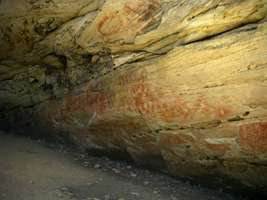
This panel contains stencils of many hands, a stencil of a coolamon, and the first of many stencils of oval decorative shell pendants, some with the trailing pendant string, and according to the display board at the site, in some cases with only the string hole. I could not find any showing the string hole. They were made from melo shell by the Cape York Aboriginals, and these 'Che-Ka-Ra' pendants were traded through other tribal groups in this area.
Text: Don Hitchcock, adapted from the display at the site.
Photo: Don Hitchcock, August 2009

This view of the panel shows, at the top, a stencil of a boomerang and a hand done in the mauve ochre tradition, as well as hands done in red ochre, as well as some red nets. There has been some defacing by modern vandals.
Photo: Don Hitchcock, August 2009
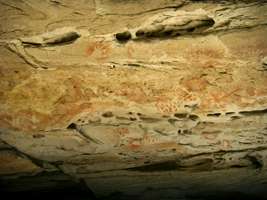
This view of the panel shows several 'Che-Ka-Ra' pendants, as well as an apparent cross. However one of the most interesting parts of this photo is the pattern of red dots, possibly made with a thumb dipped in ochre. The meaning is unclear to me.
Photo: Don Hitchcock, August 2009

'Che-Ka-Ra' pendants, some with the string by which they were attached - note that the string is apparently a single thong, or possibly a neck loop which has been twisted together for the stencilling process. In addition, there are some red ochre hand stencils.
Photo: Don Hitchcock, August 2009
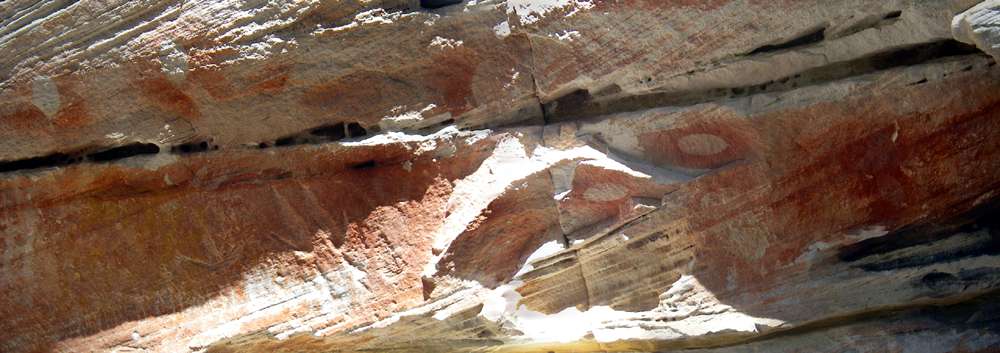
Panoramic image of one section of the wall with 'Che-Ka-Ra' pendants, and engravings of an emu print and a pair of kangaroo prints.
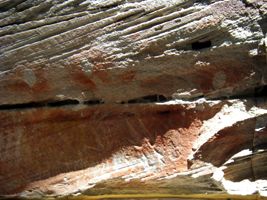
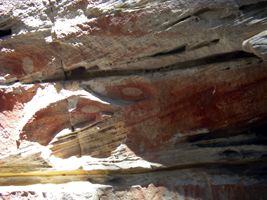
These are the original photos used for the panorama above.
Photo: Don Hitchcock, August 2009
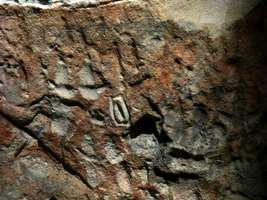
This section of the wall has several ages of engravings, as evidenced by the different amount of patination on the engravings. The most recent are a somewhat angular vulva and what appears to be a pair of kangaroo prints, but there are older engravings which may be of a small four-fingered hand, and other unidentifiable animal prints engraved in the surface.
Photo: Don Hitchcock, August 2009
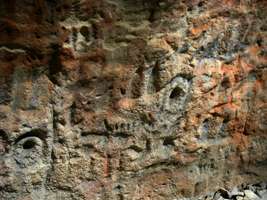
This section has at least two vulvas, as well as a pair of kangaroo prints, an emu print, and a hand engraved on the wall. All have been on the wall long enough to acquire a patina from the weather.
Photo: Don Hitchcock, August 2009
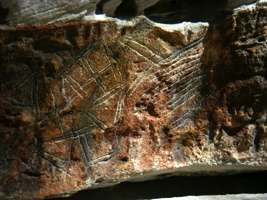
This is a most unusual set of engravings, of straight lines in patterns that come close to representing a window pane in one part, but with almost random pairs of parallel lines elsewhere, as well as a series of single lines all parallel to each other.
Photo: Don Hitchcock, August 2009
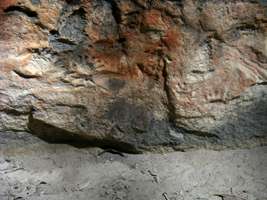
This section has several engravings of human hands, as well as what appear to be kangaroo prints.
Photo: Don Hitchcock, August 2009
